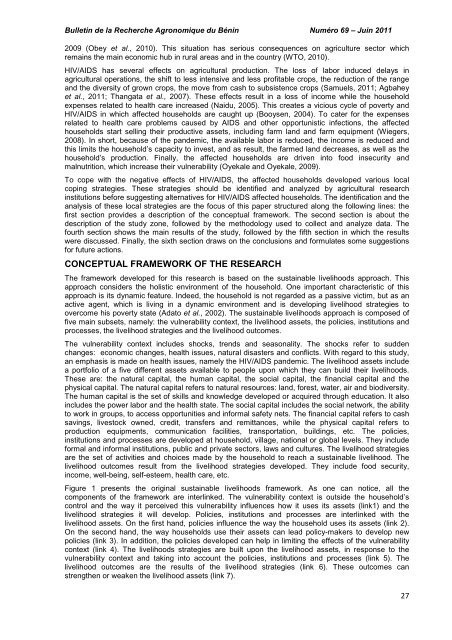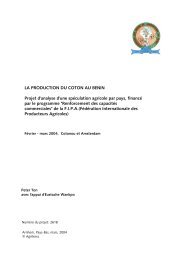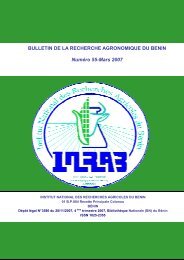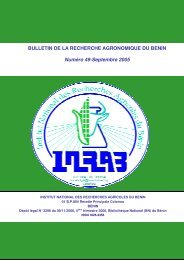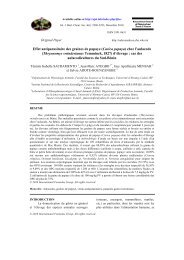Lien externe ou de téléchargement - Slire
Lien externe ou de téléchargement - Slire
Lien externe ou de téléchargement - Slire
- No tags were found...
Create successful ePaper yourself
Turn your PDF publications into a flip-book with our unique Google optimized e-Paper software.
Bulletin <strong>de</strong> la Recherche Agronomique du Bénin Numéro 69 – Juin 20112009 (Obey et al., 2010). This situation has seri<strong>ou</strong>s consequences on agriculture sector whichremains the main economic hub in rural areas and in the c<strong>ou</strong>ntry (WTO, 2010).HIV/AIDS has several effects on agricultural production. The loss of labor induced <strong>de</strong>lays inagricultural operations, the shift to less intensive and less profitable crops, the reduction of the rangeand the diversity of grown crops, the move from cash to subsistence crops (Samuels, 2011; Agbaheyet al., 2011; Thangata et al., 2007). These effects result in a loss of income while the h<strong>ou</strong>sehol<strong>de</strong>xpenses related to health care increased (Naidu, 2005). This creates a vici<strong>ou</strong>s cycle of poverty andHIV/AIDS in which affected h<strong>ou</strong>seholds are caught up (Booysen, 2004). To cater for the expensesrelated to health care problems caused by AIDS and other opportunistic infections, the affectedh<strong>ou</strong>seholds start selling their productive assets, including farm land and farm equipment (Wiegers,2008). In short, because of the pan<strong>de</strong>mic, the available labor is reduced, the income is reduced andthis limits the h<strong>ou</strong>sehold’s capacity to invest, and as result, the farmed land <strong>de</strong>creases, as well as theh<strong>ou</strong>sehold’s production. Finally, the affected h<strong>ou</strong>seholds are driven into food insecurity andmalnutrition, which increase their vulnerability (Oyekale and Oyekale, 2009).To cope with the negative effects of HIV/AIDS, the affected h<strong>ou</strong>seholds <strong>de</strong>veloped vari<strong>ou</strong>s localcoping strategies. These strategies sh<strong>ou</strong>ld be i<strong>de</strong>ntified and analyzed by agricultural researchinstitutions before suggesting alternatives for HIV/AIDS affected h<strong>ou</strong>seholds. The i<strong>de</strong>ntification and theanalysis of these local strategies are the focus of this paper structured along the following lines: thefirst section provi<strong>de</strong>s a <strong>de</strong>scription of the conceptual framework. The second section is ab<strong>ou</strong>t the<strong>de</strong>scription of the study zone, followed by the methodology used to collect and analyze data. Thef<strong>ou</strong>rth section shows the main results of the study, followed by the fifth section in which the resultswere discussed. Finally, the sixth section draws on the conclusions and formulates some suggestionsfor future actions.CONCEPTUAL FRAMEWORK OF THE RESEARCHThe framework <strong>de</strong>veloped for this research is based on the sustainable livelihoods approach. Thisapproach consi<strong>de</strong>rs the holistic environment of the h<strong>ou</strong>sehold. One important characteristic of thisapproach is its dynamic feature. In<strong>de</strong>ed, the h<strong>ou</strong>sehold is not regar<strong>de</strong>d as a passive victim, but as anactive agent, which is living in a dynamic environment and is <strong>de</strong>veloping livelihood strategies toovercome his poverty state (Adato et al., 2002). The sustainable livelihoods approach is composed offive main subsets, namely: the vulnerability context, the livelihood assets, the policies, institutions andprocesses, the livelihood strategies and the livelihood <strong>ou</strong>tcomes.The vulnerability context inclu<strong>de</strong>s shocks, trends and seasonality. The shocks refer to sud<strong>de</strong>nchanges: economic changes, health issues, natural disasters and conflicts. With regard to this study,an emphasis is ma<strong>de</strong> on health issues, namely the HIV/AIDS pan<strong>de</strong>mic. The livelihood assets inclu<strong>de</strong>a portfolio of a five different assets available to people upon which they can build their livelihoods.These are: the natural capital, the human capital, the social capital, the financial capital and thephysical capital. The natural capital refers to natural res<strong>ou</strong>rces: land, forest, water, air and biodiversity.The human capital is the set of skills and knowledge <strong>de</strong>veloped or acquired thr<strong>ou</strong>gh education. It alsoinclu<strong>de</strong>s the power labor and the health state. The social capital inclu<strong>de</strong>s the social network, the abilityto work in gr<strong>ou</strong>ps, to access opportunities and informal safety nets. The financial capital refers to cashsavings, livestock owned, credit, transfers and remittances, while the physical capital refers toproduction equipments, communication facilities, transportation, buildings, etc. The policies,institutions and processes are <strong>de</strong>veloped at h<strong>ou</strong>sehold, village, national or global levels. They inclu<strong>de</strong>formal and informal institutions, public and private sectors, laws and cultures. The livelihood strategiesare the set of activities and choices ma<strong>de</strong> by the h<strong>ou</strong>sehold to reach a sustainable livelihood. Thelivelihood <strong>ou</strong>tcomes result from the livelihood strategies <strong>de</strong>veloped. They inclu<strong>de</strong> food security,income, well-being, self-esteem, health care, etc.Figure 1 presents the original sustainable livelihoods framework. As one can notice, all thecomponents of the framework are interlinked. The vulnerability context is <strong>ou</strong>tsi<strong>de</strong> the h<strong>ou</strong>sehold’scontrol and the way it perceived this vulnerability influences how it uses its assets (link1) and thelivelihood strategies it will <strong>de</strong>velop. Policies, institutions and processes are interlinked with thelivelihood assets. On the first hand, policies influence the way the h<strong>ou</strong>sehold uses its assets (link 2).On the second hand, the way h<strong>ou</strong>seholds use their assets can lead policy-makers to <strong>de</strong>velop newpolicies (link 3). In addition, the policies <strong>de</strong>veloped can help in limiting the effects of the vulnerabilitycontext (link 4). The livelihoods strategies are built upon the livelihood assets, in response to thevulnerability context and taking into acc<strong>ou</strong>nt the policies, institutions and processes (link 5). Thelivelihood <strong>ou</strong>tcomes are the results of the livelihood strategies (link 6). These <strong>ou</strong>tcomes canstrengthen or weaken the livelihood assets (link 7).27


